1940's Dress Style 1940's Women Fashion
1950s Fashion
Although the Second World War was announced as over in 1945 its effects lasted well into the 1950s, and specially affected 1950s Fashion .
Coin and materials were still in brusque supply, and efforts were concentrated on priorities like clearing bomb sites and trying to get a devastated Britain back to normal, not fashion.
Simply still, part of feeling normal for many British women was in looking fashionable, and despite disapproval from some quarters by the cease of the 1940s versions of French styles which cocked a snook at things similar fabric shortages, practicality, or a woman'southward ability to work were increasingly beingness seen in Britain.
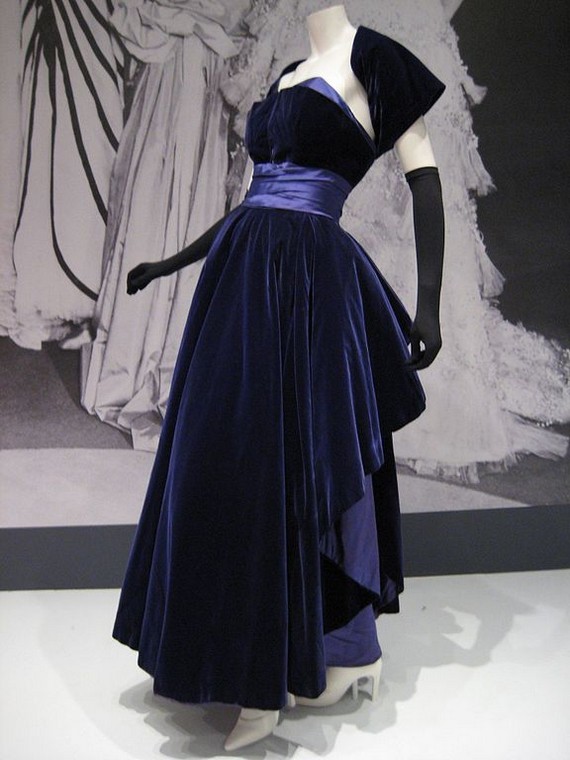
Dark blue, silk velvet and silk satin Christian Dior ballgown with matching shrug, at the Indianapolis Museum of Fine art, 1957
Women Return Home From Work
Nigh women who had worked during the state of war were fired to make style for returning men, and found themselves housewives again. Some preferred not to piece of work outside the home and enjoyed the new 1950s fashionable confections which were definitely non designed for manual labour. They said they felt dainty again. Others were more ambivalent.
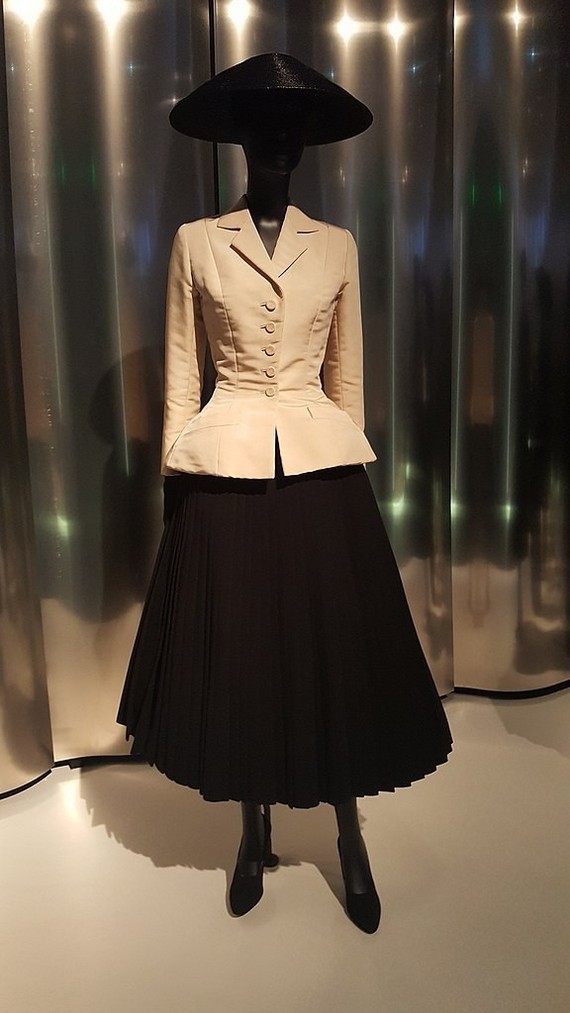
Bar suit from 1947, Dior's New Wait Corolle drove, Spring, Summertime, 1947
The New Look
The predominant silhouette made famous by Christian Dior only also seen in other French collections, had a tiny waist, fitted meridian half with pointed breasts, and a full skirt to but below the human knee. Dior called it his Corolla collection (likening a woman in his skirts to the dainty corolla of a flowers petals). It was well-nigh famously known as "The New Look", and was to become a style that dominated 1950s manner .
Teenagers, kickoff in America and then elsewhere, began to intermission away from their mother's stiff styling and develop their ain rockabilly or beatnik styles.
In Britain, the scandalous Duke and Duchess of Windsor, the ex-King Edward and Wallis Simpson, despite their shocking status (the Rex had renounced his throne in order to married the divorcee) were both considered the prototype of fashion. "My husband gave upwards everything for me… I'm not a cute woman. I'g nix to expect at, and so the only thing I tin can do is clothes better than anyone else.
"If everyone looks at me when I enter a room, my husband tin feel proud of me. That's my chief responsibility." said Wallis Simpson at the fourth dimension.
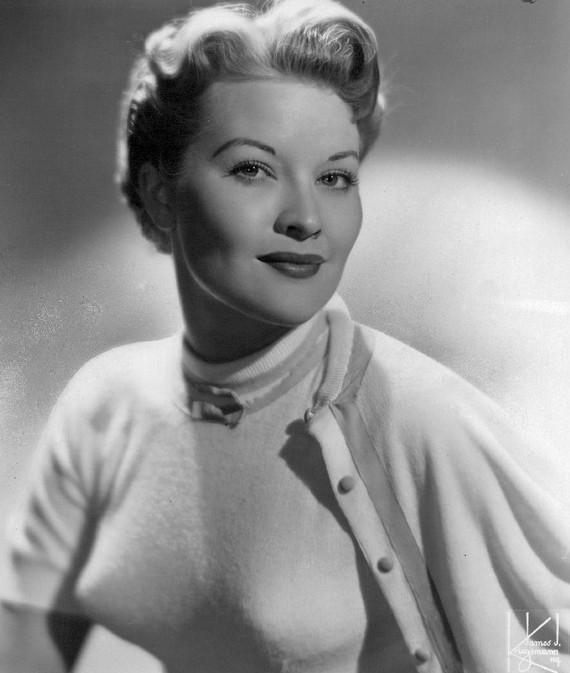
Patti Folio, 1955
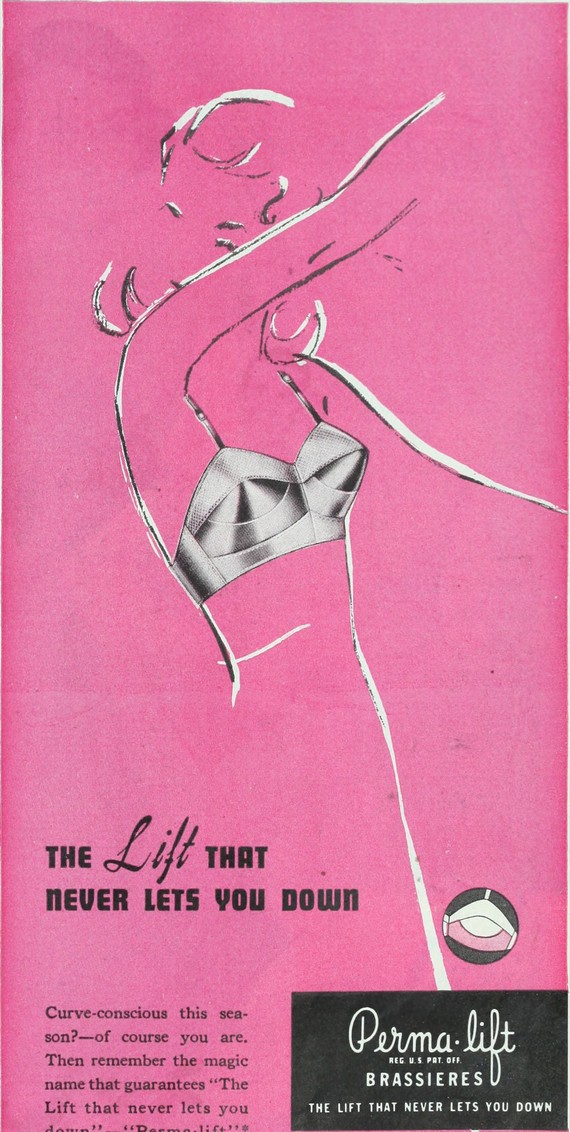
Permalift brassieres advertisement from The Ladies' home journal, 1948
50s style – Underwear
Underpinnings were a really of import role of the 1950s stylish adult female's outfit in womens wear. Whether the skirt was full or slender, if information technology was a clothes she was wearing or a skirt suit, or even a youthful sweater girl look, information technology all started with a nipped in waist and rounded hips, achieved with a "waspie" girdle, and the pointiest bra seen in history.
The girdle had stocking suspenders attached. Tights were not to become popular until the 1960s In between were worn knickers. All of these were made in the new improved piece of cake-care and affordable human being-made fabrics similar nylon.
For special occasions skirts were held out by crinoline cages or stiff net petticoats, although when worn without they had a soft, draped advent, and hips were sometimes padded as well.
This is the period where American teens wore "bobby socks" under their stilettos.
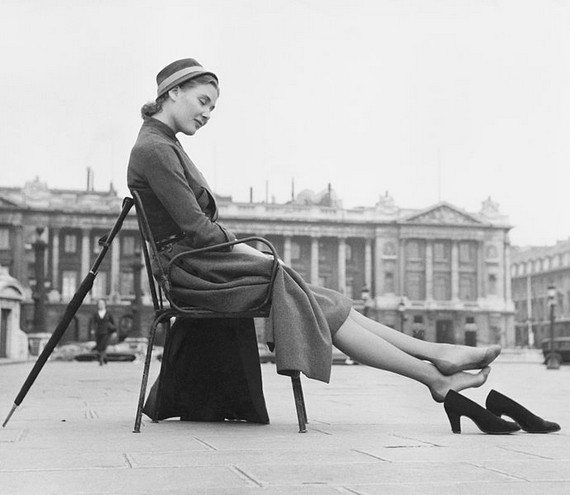
Woman in clothes and hat ,1950s
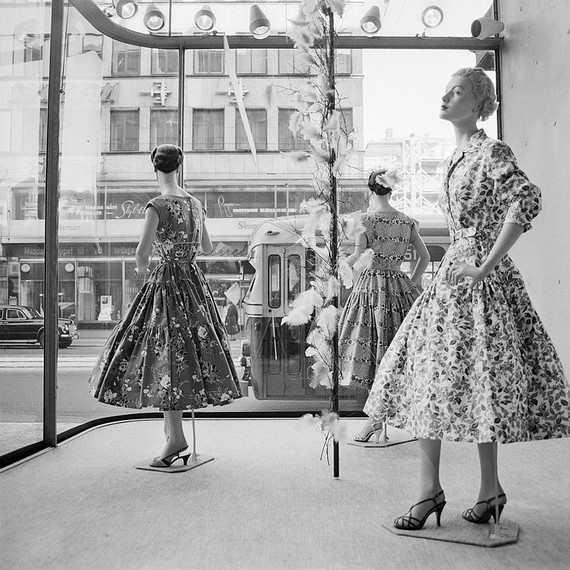
1950s cotton fiber print dresses with wide circle skirts on display in Storefront at Norrmalmstorg in Stockholm, 1957
Style in the 1950s – Daywear
Wartime Utility clothing had really been helpful in streamlining Great britain's ready to wear clothing industry, and making clothing factories more efficient. The more stripped down styles introduced by necessity during the war remained past choice during peace time, and became peradventure fifty-fifty simpler.
Block colours replaced prints for tailored vesture and neatly tailored suits with pencil skirts or fitted dresses along the same lines were most suitable for work and shopping.
But for relaxed cotton summer sundresses prints ran riot, with stripes, spots and multi coloured florals in just about any color combination available.
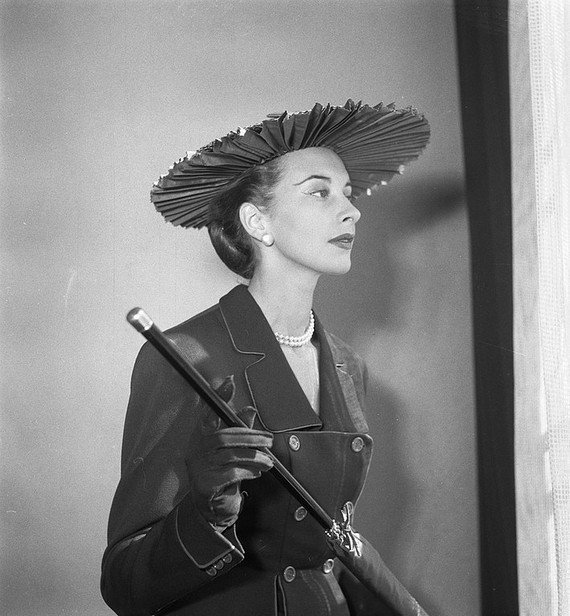
Pierre Balmain costume from fashion show, 1951
Top 1950s Way designers
Top French designers of the mean solar day included the same Christian Dior, also as Jaques Fath, Nina Ricci, Coco Chanel, Pierre Balmain, Hubert de Givenchy and Christobal Balenciaga.
Dior, Fath and Ricci presented variations on the New Wait, with a tailored jacket and pencil or total skirt.
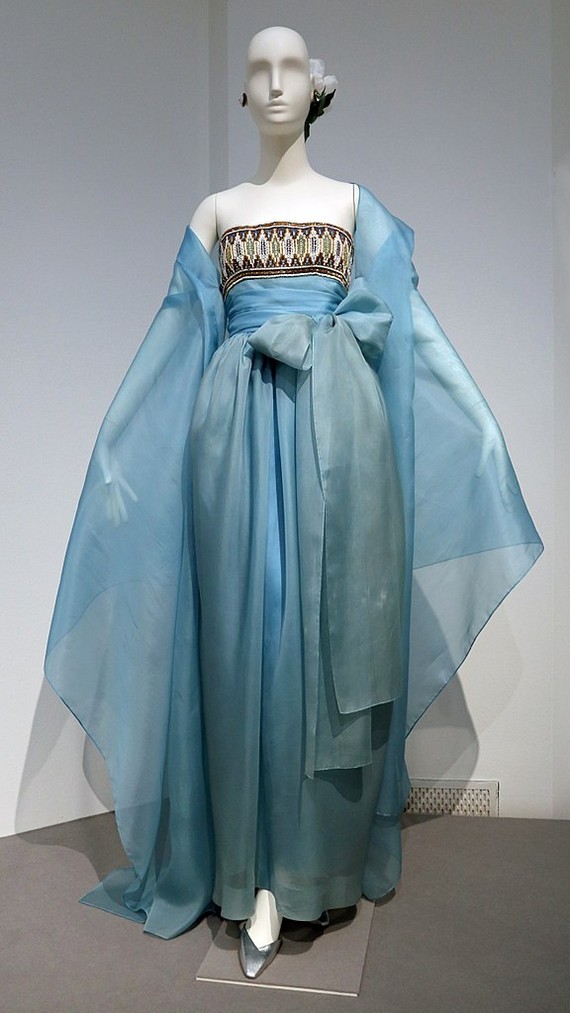
Givency, blue evening dress, from audrey hepburn's private wardrobe.1991
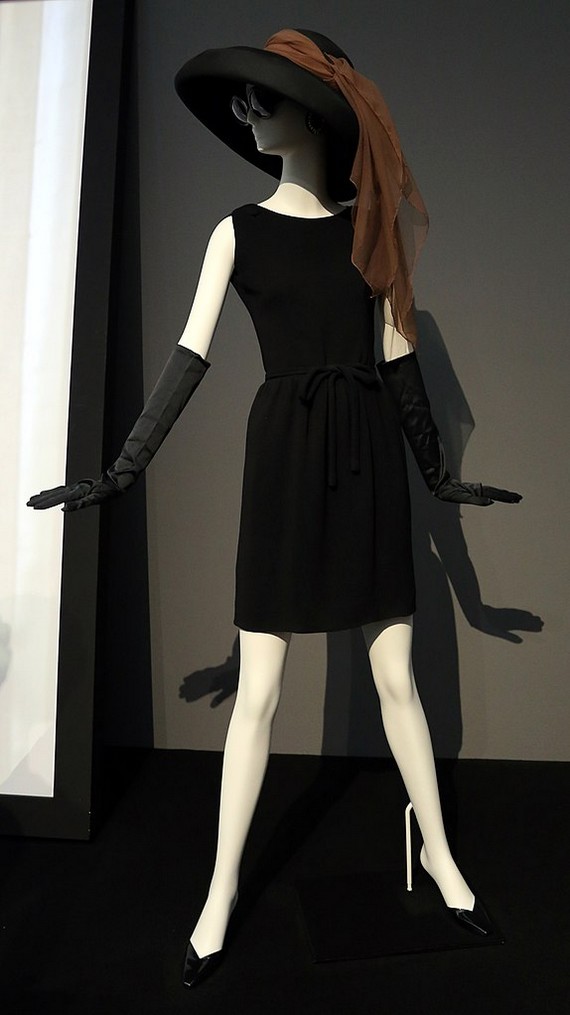
Givency niggling blackness dress and chapeau, worn by audrey hepburn in breakfast at tiffany'due south , 1961
Givenchy
Givenchy's wear was less stuffy, less padded and structured. He presented separates that could be mixed and matched and was later to become incredibly famous for dressing Audrey Hepburn in some of her virtually iconic roles.
During the 1950s, Chanel chose to stay mainly with her boxy border-to-border "cardigan jackets", in the style which had been and then popular since the late 1920s, teamed with a matching directly knee-length brim.
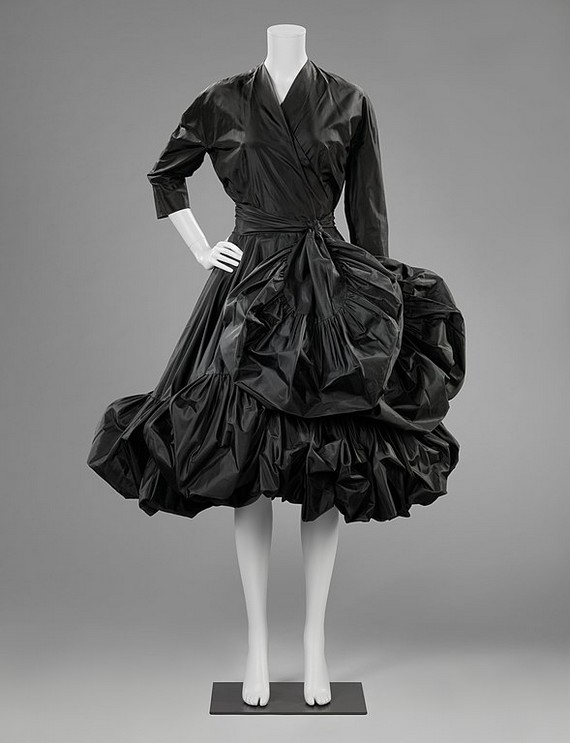
Cristóbal Balenciaga Cocktail gown, 1951
Balenciaga
Christobel Balenciaga , a Spanish-born designer who had settled in Paris, went the opposite style to the New Look, creating loose fluid designs and continually experimenting with the silhouette. He introduced the balloon jacket in 1953, and in 1955 it was the tunic apparel. In 1957 he changed direction and showed the high-waited babydoll dress. His cocoon glaze is a classic shape that has been returned to in recent years.
London had its own pocket-size but growing design scene, more often than not based on tweeds and tailoring rather than Paris's more than elaborate confections.
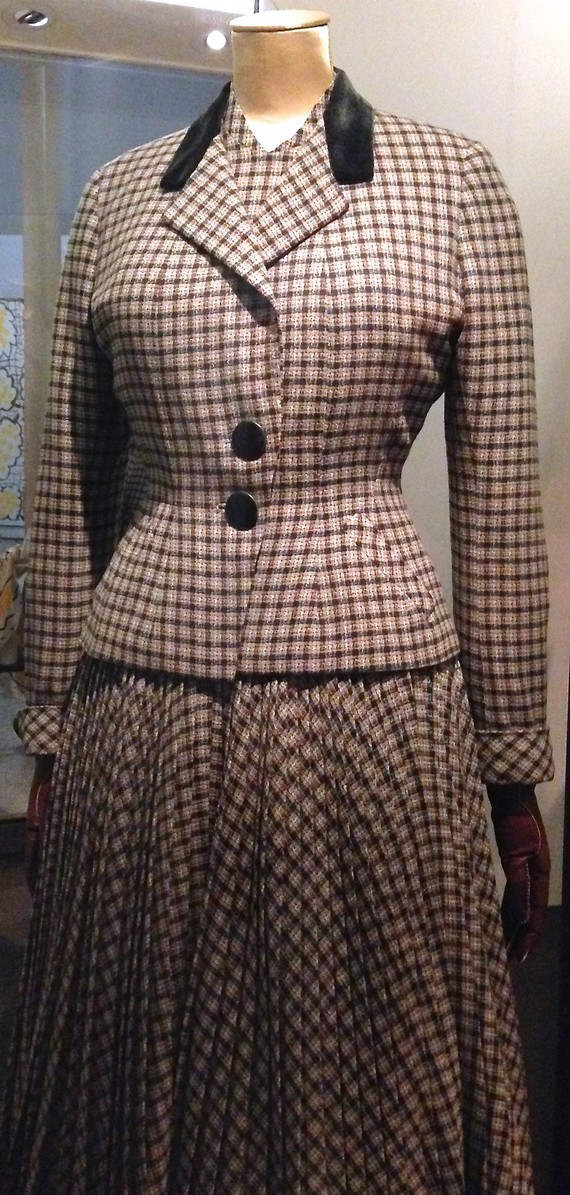
Digby Morton jacket and apparel
Amies and Hartnell
Hardie Amies who trained as a tailor, designed the Princess Elizabeth (soon to be the Queen)'due south dresses for a tour of Canada in 1950 and ran a West End couture salon for anyone who wanted a slice of her very conventional and right kind of understated elegance that every bit he said "Didn't frighten the horses".
Norman Hartnell, another London couturier, designed her coronation gown in 1953 and went on to design many other outfits for the royal likewise as London society, and Digby Morton continued his wartime success in producing pared down tailoring inspired past menswear.
America, which had non actually celebrated its own designers until the Second Globe State of war either but looked to see what Paris was doing, now had a distinct style of its own, following full general trends but with its own signature stamp. American designers, like Claire McCardell made clothes that were mostly more than practical and comfortable, though American clothes were oftentimes considered loud and brash by English visitors at the time.
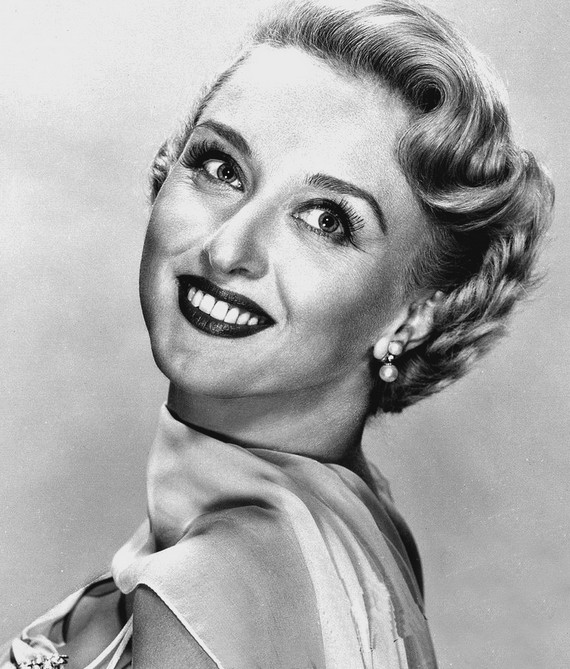
Publicity still of Celeste Holm for movie The Tender Trap, 1955
1950s Fashion – Womens Hair
American teen bobbysoxers (and the British girls who copied them) wore the classic youthful ponytail, absurd French gamines favoured a curt soft ingather, and a deep fringe was worn by some, but ladies stuck to elegant but stiff structured waves off the face. Pilus could be loose and neck to chin length, or if longer gathered usually in a bun at the back of the head, merely always carefully arranged.
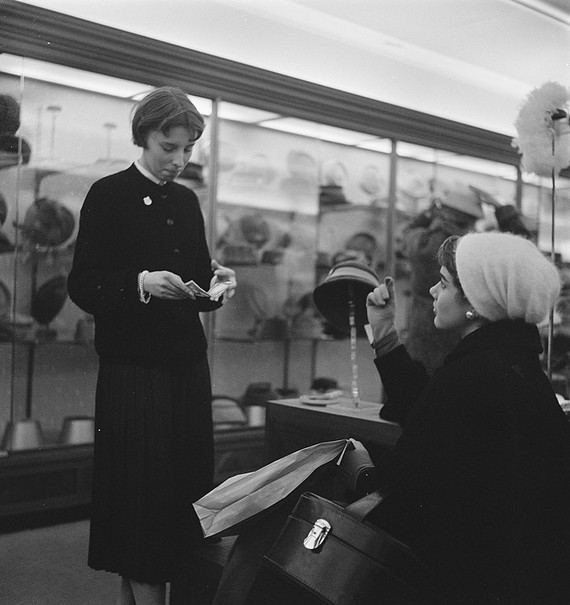
Woman shopping for hats in millinary section, 1957
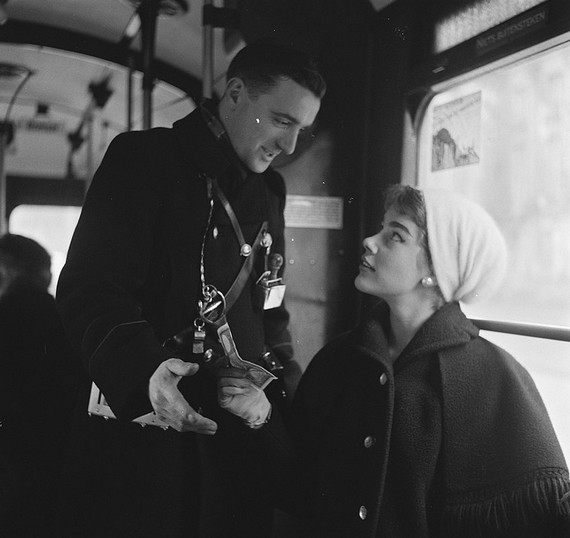
Woman wearing 1950s mohair wool hat, 1957.
1950s Fashion – Womens Hats and accessories
Times were changing, and it was no longer shocking to be seen out on the street without a hat and gloves on. Merely a formally dressed lady still wore brusk white cotton wool gloves for daytime, and a decorative lid. Hats were actually creative, and not necessarily designed to provide winder warmth or summer shade, but more as a finishing touch.
The large shallow pyramid of the "coolie" straw hat was popular, every bit were modest straw boaters. Smaller hats tended to be set right in the middle of the head, roofing the pinnacle of the brow but not any further, and not tilted at an angle.
Kerchiefs over the caput were a more than casual look, as were berets.
Sunglasses had been pop since the 1930s, merely were now becoming really widespread, with women wearing them not simply to protect their eyes from the sun but to look cool besides. The true cat'due south centre shape was universal, on both sunglasses and eye spectacles.
The even so popular Kelly handbag past Hermes was used in a 1954 film, To Catch a Thief, starring Garce Kelly. Kelly kept the handbag and was photographed in public with it, which made information technology ultra popular, although information technology wasn't actually re-named the kelly until 1977. The Kelly is a large, structured bag, worn over the arm. These types of bags and envelope clutches in colours co-ordinating to shoes for evening were popular.
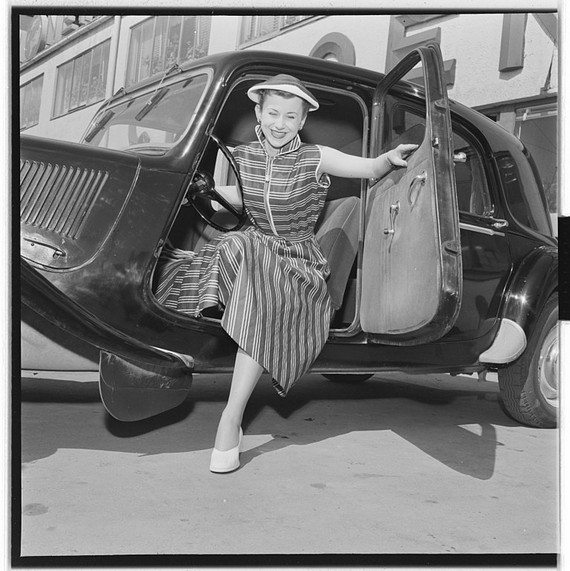
Woman weairing 1950s striped apparel and white shoes alights from car, 1954
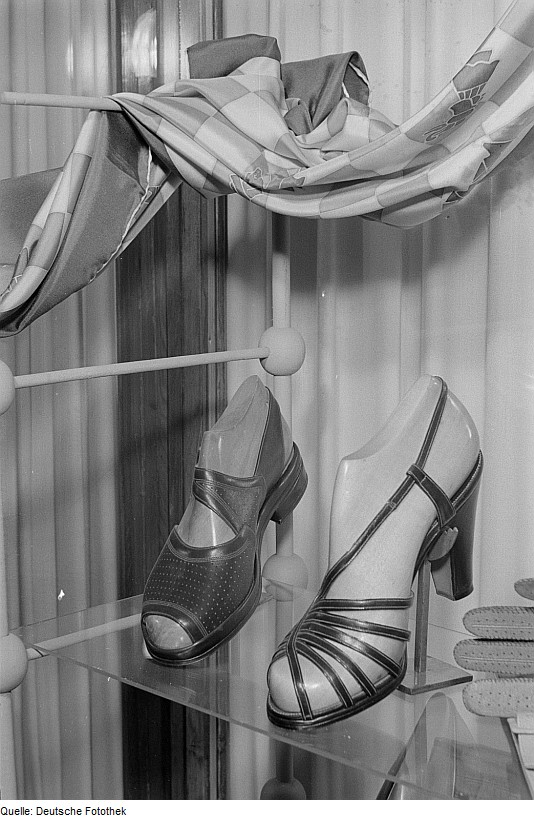
Glass showcase with women's 1950s shoes fabricated of leather and a scarf, 1953
1950s Womens wear – Shoes
The engineering of the stiletto shoe had just been invented in 1950s Manner, utilising a steel core to created a strong, slender heel, the highest and thinnest possible withal. It was popular when added to a courtroom shoe type shape, alongside more sturdy looking merely just as high heel, kitten heels and flat shoes in the form of correspondence shoes, ballet pumps and brogues.
Matching shoe and manus bag colours was the formal manner to dress.
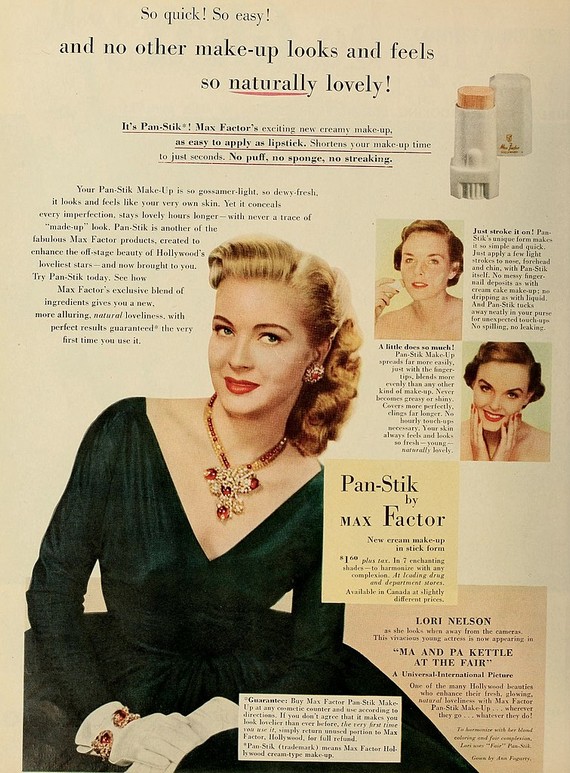
Lori Nelson in Pan-Stik by Max Cistron ad, 1952
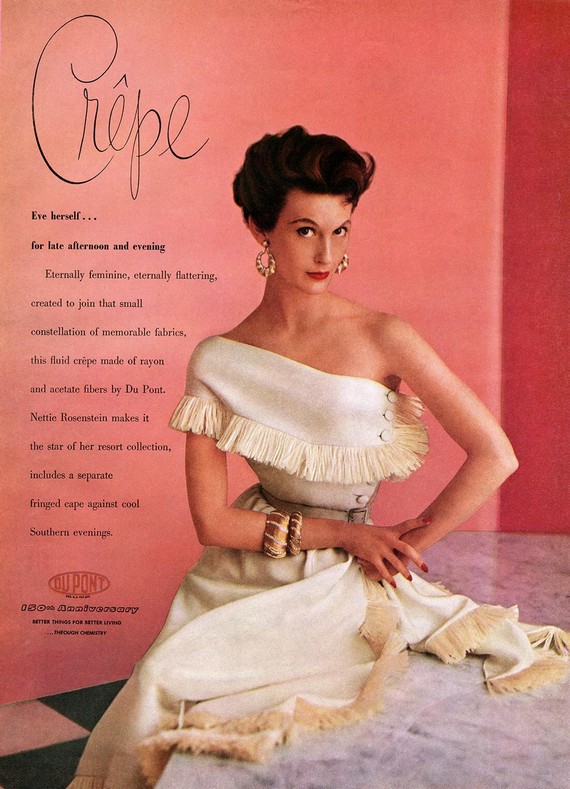
Mary Jane Russell wearing wearing apparel past Nettie Rosenstein, 1952
1950s Fashion – Makeup and perfume
The 1950s style for make up was to have matching lips and nails, usually in a shade of red simply coral was a relaxed, summer holiday wait, and soft pink or sugar pink was for teenagers or the ingenue wait. Foundation was quite heavy, meant to be flawless, pink blush faintly emphasised the stylish high cheekbones, and eyebrows were heavily emphasised. The most immediately recognisable make upwardly look in 1950s fashion, however, is the "true cat eye" flick of eyeliner.
Lighter and fresher perfumes became more popular post-war, and Miss Dior, which had been launched by Christian Dior in 1947 was one of the top sellers. L'Air du Temps by Nina Ricci was released in 1948, and then there was the more than affordable Soir de Paris by Bourjois for teenagers. Ii other less exclusive perfumes were brought out by the make up brand Max Factor: Hypnotique and Primitif. Finally for those who still preferred a seductive olfactory property, Femme de Rochas, a heavy, sultry perfume created in 1944, was for the femmes fatales.
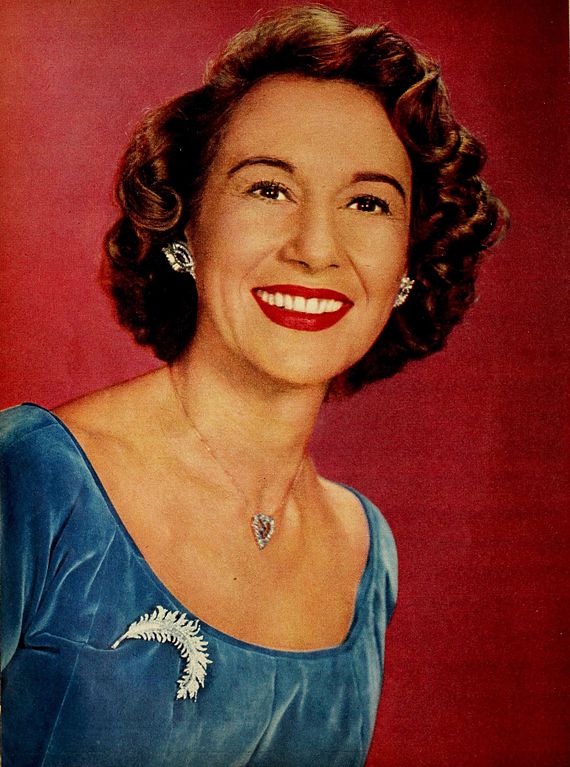
Arlene Francis – TV Radio Mirror, February 1957
1950s Fashion – Jewellery
The overriding jewellery expect for the elegant 1950s lady was a string, or a double string, of graduated real pearls, designed to fall to the neckband-bone. These were matched with large pearl push earrings.
Large and bright costume jewellery was acceptable for daytime, and again earring tended to exist quite big and circular, shut to the head and not dangly. Matching sets of bold earrings and necklaces were popular. Brooches were worn on suit lapels. Bracelets and unimposing rings were sometimes worn, merely on the whole the focus was on the head and neck.
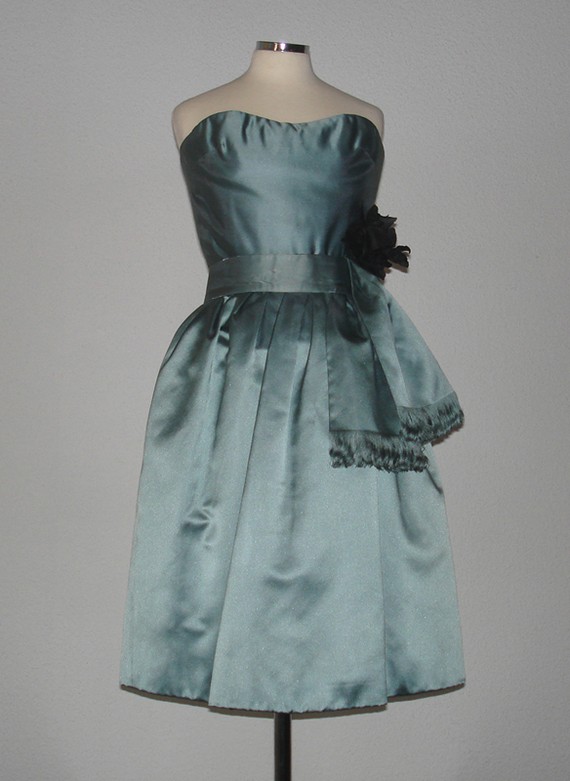
-Bluish satin strapless cocktail wearing apparel by Yves Saint Laurent for Christian Dior, Paris, 1959
1950s Style – Evening wear
The New Look silhouette of course carried through to the evening in 1950s style, with the hourglass shape accentuated past slim silk sheath or fit and flare dresses sometimes strapless with a bustier acme. They were knee joint-length for cocktails or down to the ground for formal events.
Couturier Charles James created wonderfully inventive structured gowns during this menstruum, such equally his "Four Leafage Clover" design.
On the other stop of the scale in 1950s Fashion, man-made satins were getting better and were used as a much cheaper substitute for real silk. In America, Norman Norell was raising eyebrows with his innovative evening wear that combined "day" fabrics like tweed or cotton with luxurious silk and fur.
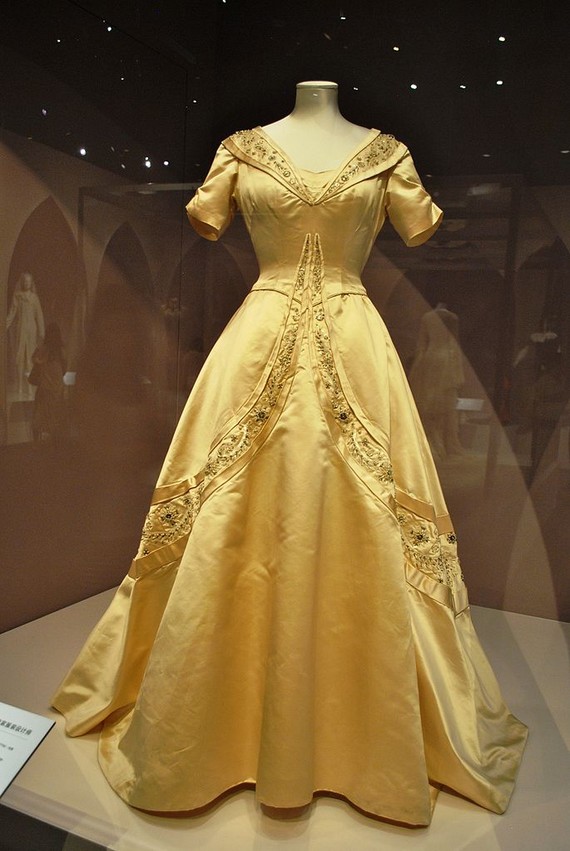
1951 yellow silk satin wedding dress by Norman Hartnell
1950s Manner – Wedding dresses
The nuptials of the year (or even of the Century, some called it – though Grace Kelly herself called information technology "The Carnival of the Century") was that of Grace Kelly and Prince Rainier of Monaco, in 1956.
Her dress was made from 25 yards of silk taffeta and used antique rose-point lace and pearls. Information technology had a fitted bodice overlaid with lace to the throat, culminating in a modest standing collar and airtight with a long centre row of tiny buttons. The long sleeves were also lace, and this combined with the full brim and sweeping railroad train on Kelly's tiny frame combined in an effect that was simultaneously modest, elegant, and incredibly romantic.
It is a look that has been copied hundreds of times over, perhaps almost famously in recent years existence used as inspiration for Sarah Burton for Alexander McQueen'due south dress for Kate Middleton'southward royal hymeneals clothes in 2011.
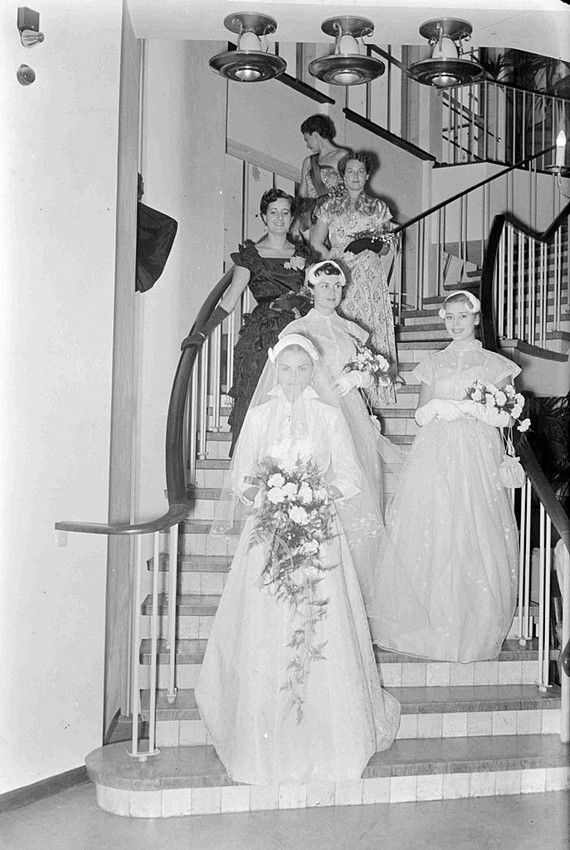
Models show white wedding dresses at fashion show in the Manner Store of Gebroeders Voss, 1953
Grace Kelly's dress was designed by MGM costume designer Helen Rose, and the dress and wedding ceremony in Monaco with its many celebrity guests was paid for by the film studio – in return for the whole event beingness filmed by them. Apparently, Kelly herself would much rather take run off and got married in a uncomplicated chapel in the mountains, an idea which her groom, Prince Rainier, laughed off as enchantingly unrealistic.
The white silk and lace wedding wearing apparel with a full length skirt and fitted bodice, worn with total length white veil was the platonic dress for a bride in the 1950s. Sometimes dresses a lilliputian above the ankle are seen, just in reality, the flouncy genu-length dresses at present billed as a "1950s wedding dress" is more than like a 1950s prom dress but in white.
1950s Fashion – Beatniks and ballet pumps
By the 1950s, not all teenagers wanted to clothes similar smaller versions of their mothers and fathers equally they usually had up until now. Some teenage girls still adopted the hourglass shape but went with the "Sweater Girl" look, wearing "coincidental" sweaters that emphasised their pointy breasts and tiny waists perfectly, but pairing them with slacks, capri pants or full skirts with fun appliqués, held out with layers of cyberspace petticoats for a more youthful result.
The coolest teenagers of the 1950s womens rejected stiff corsetry and sometimes even bras, wearing capri pants with ballet pumps and little sweaters, or, more androgynously, oversized sweaters or shirts, men's shoes and trousers, all in black. This was the Crackpot or garçonne expect.
1950s Womens habiliment – Trousers
Tight, 3-quarter length capri pants showed off delicate ankles and looked modern and immature in 1950s Fashion. They were worn much college up than we wearable trousers today, right up to the natural waist which was emphasised with a tight belt. They had a side zip, not a fly opening, and jeans which were coming into fashion for casual wearable for 1950s womens wear were the same. They could be quite tight or "boyfriend style" – in fact, just similar now, it was cute to borrow your boyfriend's or husband'south jeans, cinch them with a broad belt, and roll up the ankles.

1950s Capri-pants patterns
The silver screen star Katherine Hepburn had been wearing comfy, wide trousers paired with loose men's shirts on-screen and off since the 1930s, and she continued to influence women with this silhouette in 1950s fashion.
Nonetheless, trousers were for casual occasions just, and for more formal outings dresses were a must.
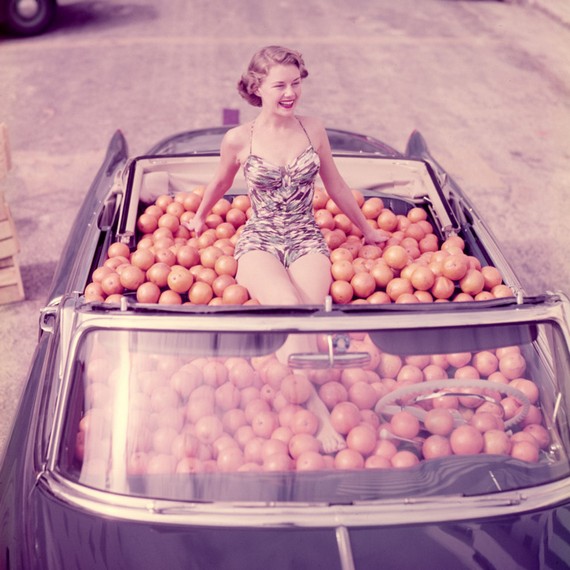
Woman in swimsuit in a car full of oranges, 1951
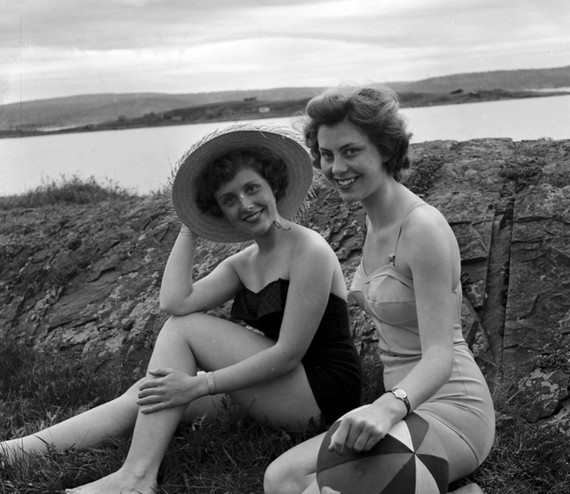
Models in bathing suits, photographed for Billedbladet NÅ, 1954 .Photographer Billedbladet NÅ Kopke-Lyn
1950s Womenswear – Swimwear
Of course, 1950s manner is famous in swimwear terms for the bikini. Never mind that the two piece was actually worn since the 1930s, the invention of information technology was claimed by French engineer Louis Reard in 1946. He announced that he named the garment after Bikini Atoll, which had become the site of a nuclear test that yr, as he thought its impact would be just every bit explosive. Hmm.
Although many announced that the way that information technology divided upwardly the body horizontally was ugly, the bikini took off profoundly in 1950s manner womens article of clothing .The one-piece pond costume was still pop however, and now often featured internal boning to maintain the desired hourglass shape of the time even on the beach.
Man fabricated fabrics for swimwear had increasingly good two-way stretch, to ameliorate mould themselves to the torso, and elasticity to cling even when wet. Wet swim suits also stale more than rapidly.These properties were also useful for sportswear to make 1950s fashion clothes that were lighter and more flexible, too equally to make every 24-hour interval clothes that stale more than quickly with less of a need for ironing.
Next >1960s Style
Vintage wool dresses – this one past Dior with beige bolero over wool dress
50s underwear-advertisement
50s Fashion bra
gamine
Fashion pattern by Balenciaga
Hardie Amies suit
Lisa Fonssagrives Penn by Irving Penn
the perfect harbinger hat
The coolie hat
1950s straw coolie hats
Cats heart glasses
The kelly bag
1950s sweater girl
Audrey Hepburn in ballet flats
1905s matching loafers and purse
1950s stilleto shoes
Women at dressing tabular array
50s makeup
50s jewellery
Mrs william-randolph hearst jr in charles james 4 leaf clover gown
Jaques-Fath-evening wear
Princess-Helene D'orleans on her wedding solar day
Grace kellys wedding-dress
Audrey Hepburn as a beatnik
Jeans in the 1950s
50s bikini suit
Jayne Mansfield in a swimsuit
Grace Kelly in 50s Evening dress
Givenchy evening dress
1950s Mens Way Clothing Styles
Motion picture inspired style – the 1950s
1950s Mens Fashion Clothing Styles
Rockabilly Dresses – 1950s Mode
50s fashion – key looks of the decade
Womens vintage jackets 1950s
1950s Womens Fashion – What did women clothing in the 1950s
1950s skirts – Ideal to requite you lot that chic retro wait
Womens 1950s vintage blouses
1950s Dresses : Find the Perfect Fit
Unforgettable 50s mode trends that are notwithstanding relevant today
Womens 1950s vintage tops
1950s Vintage Dresses
50s pin up habiliment – 1950s Pin Up Style – dresses, hair, makeup
Savehttps://www.blue17.co.u.k./vintage-blog/1950s-mens-fashion/
0 Response to "1940's Dress Style 1940's Women Fashion"
Post a Comment